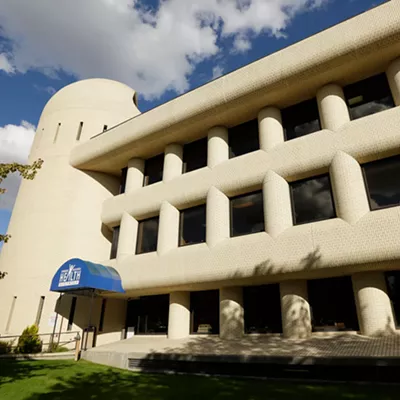
It's been almost seven years since many people living on the West Plains learned they were slowly getting exposed to "forever chemicals" in their water, whether they received Airway Heights city water or owned property with a private well.
The news that chemicals used in firefighting foam had leached into the groundwater hit like a hammer in 2017, with Fairchild Air Force Base announcing that wells around the base were testing very high for PFAS (per- and polyfluoroalkyl substances). Those chemicals bioaccumulate over time in the body and have been linked to cancers, reproductive health issues, and kidney, thyroid, and liver issues. While they're used in a huge variety of applications, from stain-resistant furniture and carpeting to grease-resistant food wrappers, the levels of toxins found in West Plains water created far higher exposure levels for people there than in most of the country.
Marcie Zambryski wonders whether that contamination led to the death of her husband. Six months after he died from thyroid complications and pancreatic cancer, she received a letter from the Air Force saying her water might be contaminated.
Zambryski is one of several residents who shared their stories for a new 20-minute documentary by the West Plains Water Coalition called Troubled Waters.
A small crowd gathered for the debut screening of the film Saturday afternoon at the HUB community center in Airway Heights, braving frigid temperatures to meet the volunteer residents working through the coalition to educate the community.
The film offers a brief history of how the chemicals came to be used in and around the West Plains, and showcases the fears and frustrations of those living in the area.
"How many years have we been drinking that water, as well as the livestock on the farm here?" coalition board member Nick Scharff says in the film. He chokes up as he says, "I worry about my new grandbaby that's here on the farm, my son, his wife — I'm concerned."
Other residents, like coalition Vice President Mo Noder, were lucky enough to be warned not to drink the water as early as 30 years ago. Noder's father and father-in-law, career military men, warned him about solvents and other chemicals that had been dumped on the base decades earlier, so his family has been driving to Spokane to fill water jugs all that time, rather than drinking from their well. He's concerned for his neighbors who didn't have that warning.
Formed in spring 2023, the West Plains Water Coalition has been awarded a two-year Public Participation Grant from the state Department of Ecology that will help the nonprofit educate the public and offer resources for safer drinking water. The film was funded in part by that grant, and the coalition plans to offer many educational meetings this year.
To watch the film and learn more, visit westplainswater.org
Ongoing research will also expand the understanding of how contamination moves through underground paleochannels and aquifers on the West Plains.
Chad Pritchard, a geology professor at Eastern Washington University, has received another grant from Ecology to create a three-dimensional groundwater model of the area. He'll be monitoring 30 sites over the next year including rivers, lakes and some of the roughly 1,500 residential wells to help understand the particle flow.
"Just north of the base, if you're in a shallow aquifer, it's contaminated, but the lower aquifer is not," Pritchard says. "When you go across Hayford [Road], the upper aquifer is not as contaminated, as far as we know so far, as the lower one because the groundwater actually transfers down."
The Air Force has tested many nearby wells, but until recently it did not test east of Hayford Road.
Last fall, the Seattle Times reported that the Spokane International Airport, which is east of Hayford, also detected PFAS contamination in 2017. But unlike the Air Force, the airport did not notify neighbors or immediately begin working with the state to remediate that pollution.
Coalition Secretary Michele Baca, who's lived on the east side of North Hayford Road since 2012, says her well has not tested at detectable levels for PFAS, but she's concerned her high cholesterol is related to drinking Airway Heights water at work. She's upset the airport didn't inform the public.
"They were egregiously duplicitous in not coming forth to the Department of Ecology. Shame on them," Baca says. "We can do better. We're killing the planet, we're killing ourselves, we need to stop it."
In good news for those east of Hayford, coalition founder John Hancock was happy to announce at the screening that the Environmental Protection Agency is partnering with Ecology and regional and state health agencies to start testing wells in that area. The EPA will be meeting with the coalition and local officials this week.
"They're going to move fast in the spring," Hancock said. "Stay tuned for information pretty soon about how to get your well tested if you live in that part of the West Plains." ♦

























